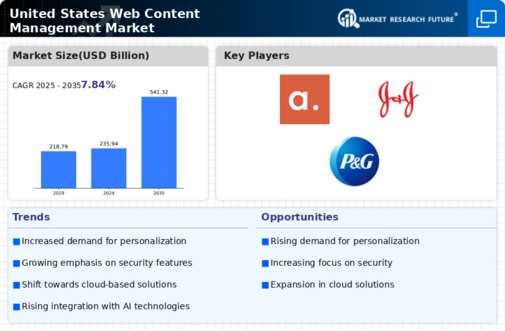Growth of E-commerce Platforms
The expansion of e-commerce platforms is significantly influencing the web content-management market. As online shopping continues to gain traction, businesses are increasingly relying on effective content management systems to enhance their e-commerce capabilities. In 2025, the e-commerce sector is expected to account for over 25% of total retail sales in the US, driving the need for integrated content management solutions. These systems enable businesses to manage product information, promotional content, and customer interactions seamlessly. Consequently, the web content-management market is likely to see a surge in demand for solutions tailored to the unique needs of e-commerce, facilitating better customer experiences and streamlined operations.
Integration of Advanced Analytics
the integration of advanced analytics into content management systems has become a key driver in the web content-management market. Organizations are increasingly leveraging data analytics to gain insights into user behavior and content performance. This trend is expected to enhance decision-making processes and improve content strategies. By 2025, it is projected that the market for analytics-driven content management solutions will grow by approximately 18%. Businesses are recognizing the value of data in optimizing their content delivery and engagement strategies. Consequently, the web content-management market is evolving to incorporate sophisticated analytics tools, enabling organizations to make informed decisions based on real-time data.
Rising Demand for Digital Content
The web content-management market is experiencing a notable surge in demand for digital content. As businesses increasingly recognize the importance of online presence, the need for effective content management solutions has become paramount. In 2025, it is estimated that the market will reach a valuation of approximately $10 billion, reflecting a growth rate of around 15% annually. This growth is driven by the necessity for organizations to engage customers through multiple digital channels, such as social media, websites, and email. Companies are investing in sophisticated content management systems to streamline their operations and enhance user engagement. The web content-management market is thus positioned to benefit from this trend, as organizations seek to optimize their content strategies to meet evolving consumer expectations.
Emphasis on Compliance and Security
In the web content-management market, compliance with regulations and security measures is becoming increasingly critical. Organizations are under pressure to protect sensitive data and adhere to various legal standards, such as GDPR and CCPA. This has led to a heightened focus on content management solutions that offer robust security features. In 2025, it is projected that the market for secure content management systems will grow by approximately 20%, as businesses prioritize safeguarding their digital assets. The web content-management market is responding to this demand by integrating advanced security protocols and compliance tools, ensuring that organizations can manage their content without compromising on safety or legal obligations.
Increased Focus on Mobile Optimization
the web content-management market is experiencing a growing emphasis on mobile optimization. With the proliferation of smartphones and tablets, businesses are recognizing the necessity of delivering content that is accessible and engaging on mobile devices. In 2025, it is anticipated that mobile traffic will account for over 70% of total web traffic, prompting organizations to invest in content management solutions that prioritize mobile responsiveness. This trend is reshaping the web content-management market, as companies seek to ensure that their content is optimized for various screen sizes and devices. As a result, the demand for mobile-friendly content management systems is likely to rise, reflecting the changing landscape of digital consumption.














Leave a Comment